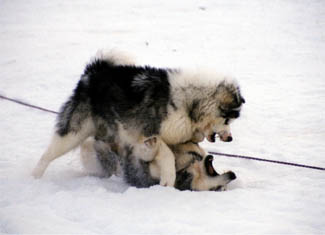Table of Contents
*
Featured Inuit Dog Owner: Ken MacRury, Part 1
*
Remembering Niya
*
Page from the Behaviour Notebook: Bishop and Tunaq
*
Antarctic Vignettes
*
On Managing ISD Aggression
*
The Qitdlarssuaq Chronicles, Part 3
*
News Briefs:
Inuit Dog Thesis Back in Print
Nunavut Quest 2003 Report
Article in Mushing Magazine
Possible Smithsonian Magazine Story
*
Product Review: Dismutase
*
Tip for the Trail: Insect Repellents
*
Book Review: The New Guide to Breeding
Old Fashioned Working Dogs
*
Video Review: Stonington Island, Antarctica 1957-58
*
IMHO: The Slippery Slope
Navigating This
Site
Index of articles by subject
Index
of back issues by volume number
Search The
Fan Hitch
Articles
to download and print
Ordering
Ken MacRury's Thesis
Our
comprehensive list of resources
Talk
to The
Fan Hitch
The Fan
Hitch home page
ISDI
home page
Editor: Sue Hamilton
Webmaster: Mark Hamilton
Contents of The Fan Hitch Website and its publications are protected by international copyright laws. No photo, drawing or text may be reproduced in any form without written consent. Webmasters please note: written consent is necessary before linking this site to yours! Please forward requests to Sue Hamilton, 55 Town Line Rd., Harwinton, Connecticut 06791, USA or mail@thefanhitch.org

Hamilton
photo
On Managing ISD Aggression
by Janice Dougherty
I think we're all seeing that managing aggression in ISDs must be appropriate for the breed, and not directly grafted from experiences with non-northern breeds; that the individual animals' temperaments and the types and circumstance of their management must be factors; and that the individual owner's tolerances and requirements as well as the general geography/local demographics must be considered as well.
Those who live closer to the relatively unpopulated, colder regions have a different sub set of challenges than those with closer proximity to non-northern dog savvy/tolerant neighbors. How all these factors mesh results in the ultimate success or failure of each dog's situation. Years ago, at a talk by Erik Klinghammer, I heard him remark that large, human males with naturally deep voices had generally less to prove to earn the respect of dogs. The late Job Michael Evans urged women owners to monitor their vocal tones and not "whine" in a singsong, baby voice, since the dogs hear the music of anxiety and lack of authority.
Physically punishing a dog should never have to be repeated with notable frequency, but judiciously available and applied early on to set a balance where it rarely gets to that stage, where voice and gesture is enough of a reminder. The need for reminders by physical contact decreases with age, if you've laid the foundation, most of the time. Yes, the dogs know we are not dogs. We can no more become pack leaders than Jack London's fictional St. Bernard X Collie could lead a wolf pack. However, the only way humans can effectively communicate with animals with whom we interact so closely is by using signals that they are set up to perceive and understand, in ways that they can easily relate to, by species.
The modern horse trainer controls movement in the round training pen, insisting on continued movement until the horse exhibits classic horse submissive signals. Then they reward cooperative behavior. The horse reads the man, and the man reads the horse. (For more information see the Equus Magazine, April, 2003 article entitled "Need to Lead".) Recent dog behavior studies clearly indicate that dogs can read us humans better than other species can read us, including supposedly "smarter" wolves and chimpanzees. In nature, many animals are attuned to the signals of other species, for food location, for danger, for territory. We are not strictly limited to "carrot and stick" - although they have their place in the spectrum of communication.
When dogs fight with each other, it is more common that dominance/precedence disputes will be focused around the face and head (this is true in people as well), whereas predatory aggression will go for the belly. Pit bull people recognize an "ear dog" or a "leg dog". Dogs seems to have their own preference for where to grab another dog. It may be an inherited motor pattern compounded by previous experiences of success, but it is inappropriate to apply modern Western human standards to dogs and call it "dirty" fighting.
Dogs are the ultimate opportunists, after all. While it is necessary to establish oneself in a safe, "in charge" position, as a respect worthy figure, it does in no way preclude affection as part of the dance. One reason given for "clicker" training successes is that it is a novel sound to most dogs. In other words, some dogs have largely tuned out a verbose owner and reduced the attention paid to the sound of his/her voice. This is part of how owners undermine their own worthiness of authority. And we must all come to grips with these realities in our own way.
Kudos to those dog drivers who have the ability to
communicate with
their dogs in such a way that they get the most out of
them with the least
need for physical "direction". Some people "get it" and
some never will.
There was a time when we humans needed to read animal sign
to survive.
Now that is no longer necessary, the inborn "gift" may
occur more randomly
in the human population, since there is little selective
pressure for it
anymore.